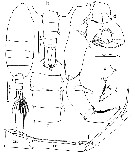
Issued from: Mulyadi, S. Nishida & S. Ohtsuka
in Crustaceana, 2017, 90 (1). [p.88, Fig.6].
Male (from 1°24.265'N, 125°07.219'E): a, habitus (dorsal); b, urosome (dorsal); c, urosomites 1-3 (dorsal); d, P5; e, exopodal segment 2 of left P5; f, right A1 (number of ancestral segment indicated by Roman numerals).
Nota:
- Prosome about 2.7 times as long as urosome.
- Posterior corners of prosome produced into asymmetrical lobes, right lobe wider than left.
- Genital somite asymmetrical, left sides lightly more produced posteriorly than right.
- Urosomite 2 furnished with posterolateral process on right side, bearing terminal setule;
- Anal somite partly fused with caudal rami.
- Caudal rami asymmetrical, right ramus wider than left.
- Appendages as in male
T. (A.) sulawesiensis, except right A1 and P5.
- P5: Right leg coxa broad without ornament; basis bearing large ladle-shaped medial process with proximal and distal setule, distal half of segment broadened and curved medially; exopod slightly curved medially with 2 setae, middle part of inner margin emarginated. Left leg coxa with medioproximal depression; basis elongate with medioproximal semi-circular process with terminal setule; exopodal segment 1 with medial digitiform process located at proximal 1/4 of segment; exopodal segment 2 with longitudinal row of setules on medial margin, proximomedial seta, minute lateral seta at mid-length, subdistal lateral seta, medial subdistal notch, and rounded tip.




